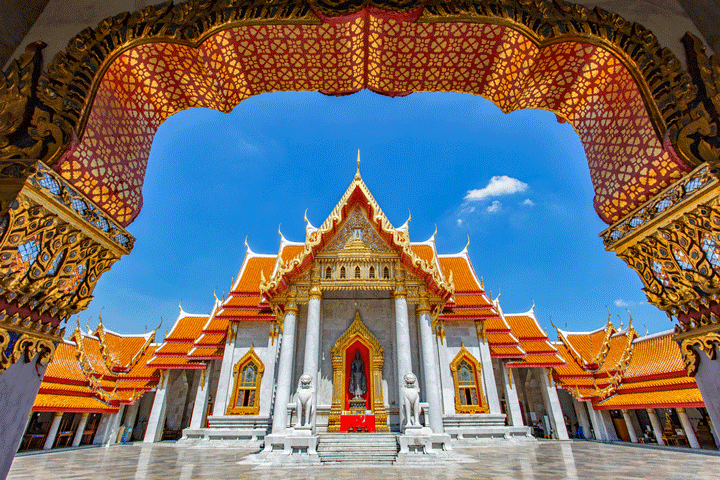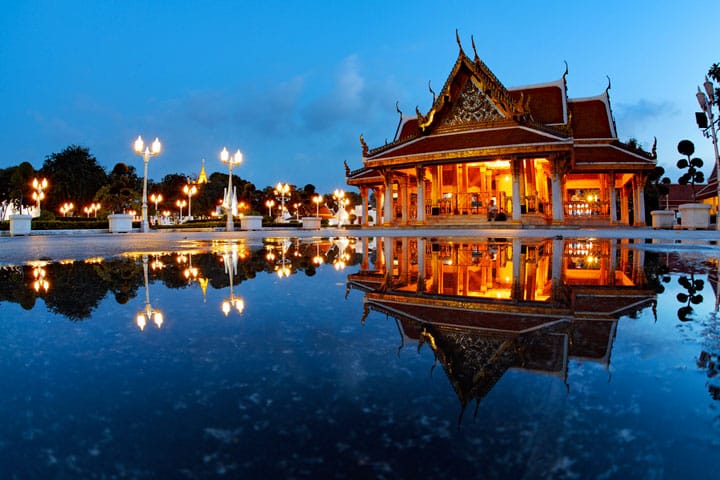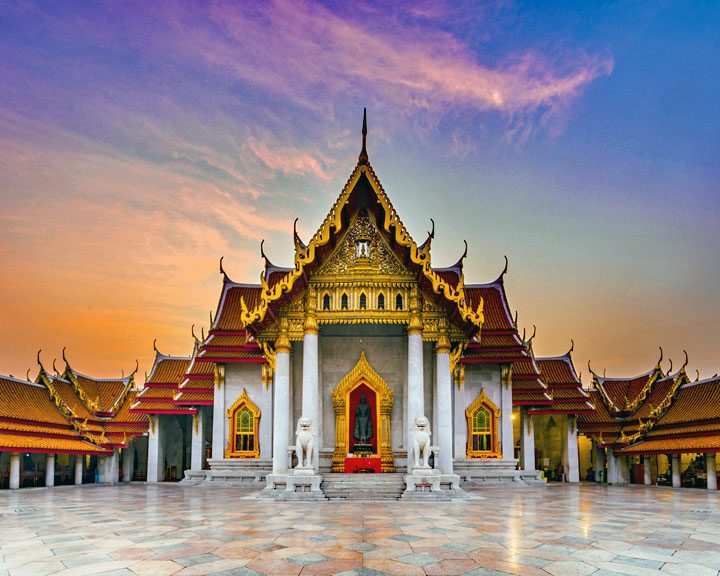Wat Benchamabophit – the marble temple

Wat benchamabophit
For most tourists who visit Bangkok, a visit to Wat Pho or Wat Phra Kaeo is a regular part of the program. Understandable, because both temple complexes are crown jewels of the cultural-historical heritage of the Thai capital and, by extension, the Thai nation. Lesser known, but highly recommended, is Wat Benchamabopit or the Marble Temple which is located on Nakhon Pathom Road by the Prem Prachakorn Canal in the heart of the Dusit district, known as the government quarter.
Wat Benchamabophit does not have the same monumental allure as Wat Pho or Wat Phra Kaeo, but it is a very aesthetically pleasing collection of beautifully designed buildings with beautiful details in the design such as the eye-catching and very beautiful stained glass windows. Moreover, from a historical point of view, it is also an interesting temple complex because of its links with the Chakri dynasty. Officially, this temple bears the name Wat Benchamabophit Dusitwanaran, but it is known as 'Wat Ben' to most residents of Bangkok. Foreign visitors and travel guides often refer to the 'Marble Temple' as a reference to the marble that was lavishly used in its construction. It was also the first temple in Thailand to use marble as a building material. Although this temple is less known and remains one of the most famous in Thailand, it is certainly no coincidence that Wat Benchamabophit is depicted on the back of the Thai 5-Baht coin.
It is - in view of the importance of this temple - somewhat strange, but hardly anything is known about the earliest history of this temple. Its origins may be traced back to a somewhat obscure temple built in the eighteenth century known as 'Wat Laem' or 'Wat Sai Thong'. When King Chulalongkorn (1853-1910) or Rama V, between 1897 and 1901, had Dusitplaleis built north of Rattanakosin, two temples, Wat Dusit and Wat Rang, had to be demolished on the area intended for the palace. It was perhaps as compensation for this demolition that Chulalongkorn had Wat Laem renovated and expanded in a grand manner….
As with a number of other nearby important buildings such as the Dusit Palace, the Ananta Samakom Throne Hall and the Government House, Wat Benchamabopit clearly shows strong foreign architectural influences. After all, the construction enthusiast Chulalongkorn is known for not averse to engaging European architects. Although that was less the case for this temple because he appointed his half-brother Prince Narisara Nuwattiwong (1863-1947) as principal for the renovation and expansion works. As a young boy, this prince was already inspired by art in the broadest sense of the word and he was not yet 23 years old when Chulalongkorn appointed him Director of Public Works and Spatial Planning in the Siamese Ministry of the Interior. He worked on the early urban planning of Bangkok and became an art consultant for the Royal Institute of Thailand. He later became Minister of Finance and Defense.
The prince was friends with a number of Italian architects, including Mario Tamagno, Annibale Rigotti and Carlo Allegri, who were responsible for a number of iconic buildings in Bangkok. It was probably under their influence that he chose the famous Italian white marble, which was transported from Carrara to Bangkok by shiploads at a time.
An important statue in the Great Hall of the temple is Phra Phuttha Chinnarat, a perfect bronze replica of the original statue from the Sukhothai period that is located at Wat Phrasi Rattana Mahathat in Phitsanulok province. The ashes of the still highly revered King Chulalongkorn were interred under the pedestal of this statue, which, in addition to the fact that the equally popular King Rama IX lived in this monastery as a novice, makes this temple one of the first-class royal temples makes.

(Wat Benchamabophit Dusitvanaram) in Bangkok
The particularly beautifully proportioned Great Hall, in the form of a five-layer square under a layered roof construction with striking yellow tiles, and the surrounding square are made entirely of marble. The combination of the window frames and roof decorations, which have been heavily painted in gold, is sometimes dazzling, especially on sunny days. On the rear balcony, one can find 52 Buddha statues in various poses collected by Prince Damrong Rajanubhab on his countless travels. Queen Saovabha Phongsri, wife and stepsister of Chulalongkorn, also played a major role in the creation of the Marble Temple. She had a hand in the construction of the Song Tham Throne Hall and the Sor Por Chapel, which were built in memory of Crown Prince Maha Vajirunhis, who had succumbed to typhus on January 4, 1895, just 16 years old. The latter structure functioned as a library for the monastic community and also contains a number of important statues of the Buddha. The Bodhi Tree located within the monastery walls is a graft of the Bodhgaya under which the Buddha in India is said to have attained the state of enlightenment…
On a slightly less pleasant note to end is the fact that the temple received negative media coverage just before the outbreak of the corona pandemic because rogue tuk-tuk drivers used it on their scam tours where unsuspecting tourists were duped…. A practice that did not exactly make the Thai authorities happy….


